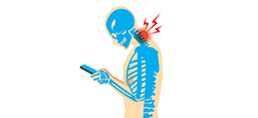
A recent study found that weak neck and shoulder muscles might contribute to tension headaches.
In the small Danish study published in the journal Cephalalgia, researchers found healthy people had neck and shoulder muscles that were 26 percent stronger than those of people suffering from regular tension-type headaches.
But Nuala Crotty, MD, a physical medicine and rehabilitation specialist at the Spectrum Health Medical Group Spine & Pain Management Center, said that while the study findings are valid, there’s more to consider.
The key? Keep those neck and shoulder muscles loose.
“Tight muscles behave like weak muscles,” Dr. Crotty said. “For most people, it’s more the tightness causing the weakness as opposed to actual weakness in the muscles.”
Most of the neck and shoulder muscle tension that causes tension headaches comes from three possible places, she said:
- Poor posture: With more and more people spending hours in front of computer screens, poor posture is common. Poor posture means your spine is not correctly aligned, making your muscles work harder. The end result is tension in your neck and head.
- Stress: Stress alone can tighten muscles, leading to tension headaches.
- Trauma: Even after healing from a traumatic injury such as a car accident, muscles can remain tight. “That tension can become your body’s new default, and it has a hard time letting go of it,” Dr. Crotty said.
Getting to the root of why your muscles are tight and taking steps to change is the key, she said. For poor posture, that might mean creating a more ergonomically correct work station.
“If we get into a good posture, we can strengthen those muscles,” she said. “If you get the neck in alignment, then your neck muscles don’t have to work so hard.”
Getting up from the computer frequently and stretching is also beneficial. Try rolling your shoulders or pinching your shoulder blades together.
“Make sure your muscles are not contracting in the same position for a lengthy period of time,” Dr. Crotty said.
To alleviate stress, she recommends deep belly breathing as a good first step.
“Deep breathing causes the body to relax,” she said.
Where might a patient go for help? Physical therapy is a good place to start, Dr. Crotty said.
Physical therapists can help you learn better posture, create an ergonomically correct work station and learn stretches to reduce muscle tension. They also can provide exercises to improve upper back strength, which is critical to good posture.
If after four to six weeks of physical therapy there is no improvement, Dr. Crotty recommends seeing a physical medicine and rehabilitation specialist such as herself.
Physical medicine and rehabilitation, also called physiatry, deals with the prevention, diagnosis and treatment of disorders of the nerves, muscles, bones and brain—anything from traumatic brain injury to lower back pain.
Dr. Crotty said she can assess the condition and order X-rays or MRI if needed, to make sure there is nothing more serious going on. She can also prescribe medications or injections to decrease the pain and make patients feel more comfortable.
 /a>
/a>
 /a>
/a>
 /a>
/a>